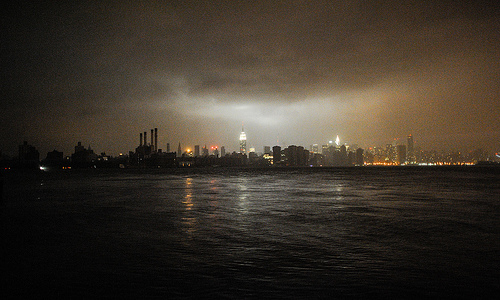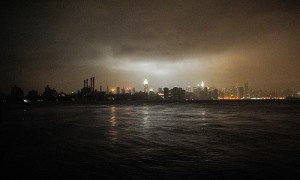
Vulnerability of Energy Infrastructure to Hurricane Sandy
In a previous blog post, I took a quick look at the immediate costs from Hurricane Sandy. Climate change made the destruction of Hurricane Sandy much worse. I noted the costs to lives, infrastructure and lost economic activity.
What about the effects of Sandy on our region’s energy infrastructure?
ConEdison, an electric utility for New York, reported that an electrical fire occurred at one of their electric substations due to flooding from the storm. The explosion is reported to be the cause of darkening New York’s iconic skyline. Lower Manhattan, including the city’s famed financial district, could be without power for days.
Also, 20 nuclear reactors were located in Hurricane Sandy’s path. As we have seen over the past few days, flooding and storm surges put much of the region’s infrastructure at risk, which includes nuclear power plants. While none have been at risk thus far, the owners of two nuclear reactors issued an “alert” – the second of a four-tier safety classification – and shut them down. The Nuclear Regulatory Commission (NRC) has been continuously monitoring the plants.
The controversial Indian Point nuclear power plant, a mere 45 miles north of New York City on the Hudson River, shut down one of its reactors because water levels rose six feet above sea level. Entergy, the owner of Indian Point, said the reactor was shut down because of “external electrical issues.”
Another reactor at the Oyster Creek in New Jersey, which was already offline for refueling, issued an alert because of high water levels.
Nuclear power plants need a constant supply of electricity to keep the reactor cool and to keep a steady flow of water for spent fuel in pool storage. If power is cut off, plants have back up diesel generators to maintain cooling. So, while the hurricane certainly warrants concern, thus far the power plants have performed as expected.
Aside from nuclear power plants, dozens of other power plants – coal, natural gas, hydropower – were at risk. So too were transmission lines, connecting these sources of power to consumers. To see a full interactive map of the energy infrastructure in Sandy’s path, check out EIA’s map here.
Also, about 70% of the region’s refineries in the northeast also shut down. These refineries are responsible for transforming crude oil into useful consumer products such as gasoline. With the facilities shuttered, gasoline shortages could be expected, which would cause a huge spike in gas prices, at least in the short-term.
However, as Steve LeVine of Quartz notes, quoting an oil trader, Hurricane Sandy could be “the biggest demand destruction event in history.” The U.S. consumes over 18 million barrels of oil a day, almost entirely for driving cars and trucks. And the east coast is the highest oil consuming region in the country, burning through 3.1 million barrels of oil a day. Except, due to the hurricane, over 50 million people have essentially been standing still for a few days now – causing oil demand to plummet. So, refinery outages may be offset by lack of demand, essentially nullifying what would be price spikes.
The nations’ energy infrastructure avoided the worst (although the same cannot be said of coastal communities and much of New York City). However, the storm is a reminder of how much we depend on energy to power our economy, much of it from fossil fuels.







[…] Sandy caused significant damage to the region’s energy infrastructure; 70% of the region’s refineries shut down, and the Indian Point nuclear power plant had to shut […]
[…] Vulnerability of Energy Infrastructure to Hurricane Sandy […]